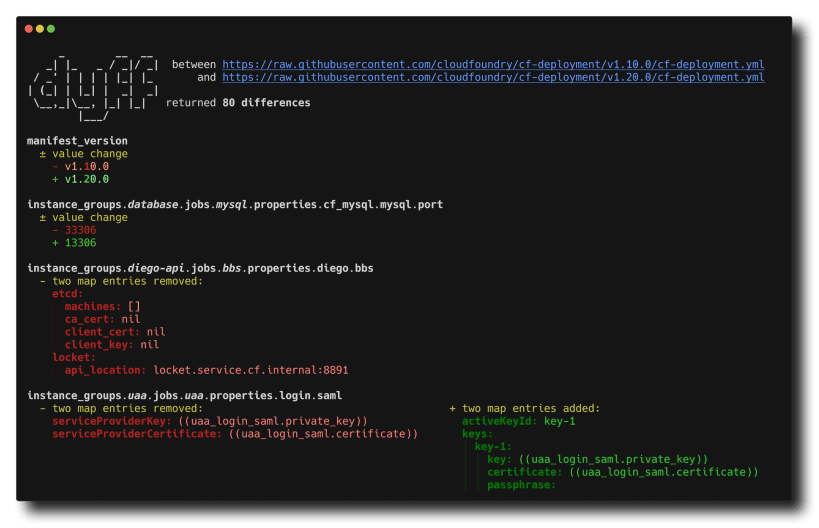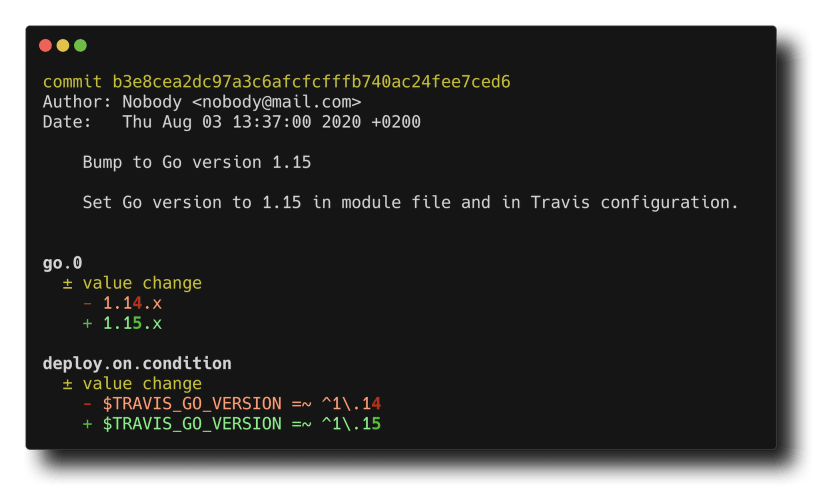


δyƒƒ /ˈdʏf/ - A diff tool for YAML files, and sometimes JSON
dyff is inspired by the way the old BOSH v1 deployment output reported changes from one version to another by only showing the parts of a YAML file that change.
Each difference is referenced by its location in the YAML document by using either the Spruce or go-patch path syntax. The output report aims to be as compact as possible to give a clear and simple overview of the change.
Similar to the standard diff tool, it follows the principle of describing the change by going from the from input file to the target to input file.
Input files can be local files (filesystem path), remote files (URI), or the standard input stream (using -).
All orders of keys in hashes are preserved during processing and output to the terminal, most notably in the sub-commands to convert YAML to JSON and vice versa.
You are about to open
Do you wish to proceed?
Thank you for your report. Information you provided will help us investigate further.
There was an error while sending your report. Please try again later.
Snaps are applications packaged with all their dependencies to run on all popular Linux distributions from a single build. They update automatically and roll back gracefully.
Snaps are discoverable and installable from the Snap Store, an app store with an audience of millions.

Snap can be installed from the command line on openSUSE Leap 15.x and Tumbleweed.
You need first add the snappy repository from the terminal. Choose the appropriate command depending on your installed openSUSE flavor.
Tumbleweed:
sudo zypper addrepo --refresh https://download.opensuse.org/repositories/system:/snappy/openSUSE_Tumbleweed snappy
Leap 15.x:
sudo zypper addrepo --refresh https://download.opensuse.org/repositories/system:/snappy/openSUSE_Leap_15.6 snappy
If needed, Swap out openSUSE_Leap_15. for, openSUSE_Leap_16.0 if you’re using a different version of openSUSE.
With the repository added, import its GPG key:
sudo zypper --gpg-auto-import-keys refresh
Finally, upgrade the package cache to include the new snappy repository:
sudo zypper dup --from snappy
Snap can now be installed with the following:
sudo zypper install snapd
You then need to either reboot, logout/login or source /etc/profile to have /snap/bin added to PATH.
Additionally, enable and start both the snapd and the snapd.apparmor services with the following commands:
sudo systemctl enable --now snapd
sudo systemctl enable --now snapd.apparmor
To install dyff, simply use the following command:
sudo snap install dyff
Browse and find snaps from the convenience of your desktop using the snap store snap.

Interested to find out more about snaps? Want to publish your own application? Visit snapcraft.io now.